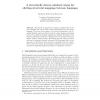Free Online Productivity Tools
i2Speak
i2Symbol
i2OCR
iTex2Img
iWeb2Print
iWeb2Shot
i2Type
iPdf2Split
iPdf2Merge
i2Bopomofo
i2Arabic
i2Style
i2Image
i2PDF
iLatex2Rtf
Sci2ools
AMTA
2004
Springer
2004
Springer
A Structurally Diverse Minimal Corpus for Eliciting Structural Mappings Between Languages
Abstract. We describe an approach to creating a small but diverse corpus in English that can be used to elicit information about any target language. The focus of the corpus is on structural information. The resulting bilingual corpus can then be used for natural language processing tasks such as inferring transfer mappings for Machine Translation. The corpus is sufficiently small that a bilingual user can translate and wordalign it within a matter of hours. We describe how the corpus is created and how its structural diversity is ensured. We then argue that it is not necessary to introduce a large amount of redundancy into the corpus. This is shown by creating an increasingly redundant corpus and observing that the information gained converges as redundancy increases.1
| Added | 30 Jun 2010 |
| Updated | 30 Jun 2010 |
| Type | Conference |
| Year | 2004 |
| Where | AMTA |
| Authors | Katharina Probst, Alon Lavie |
Comments (0)

